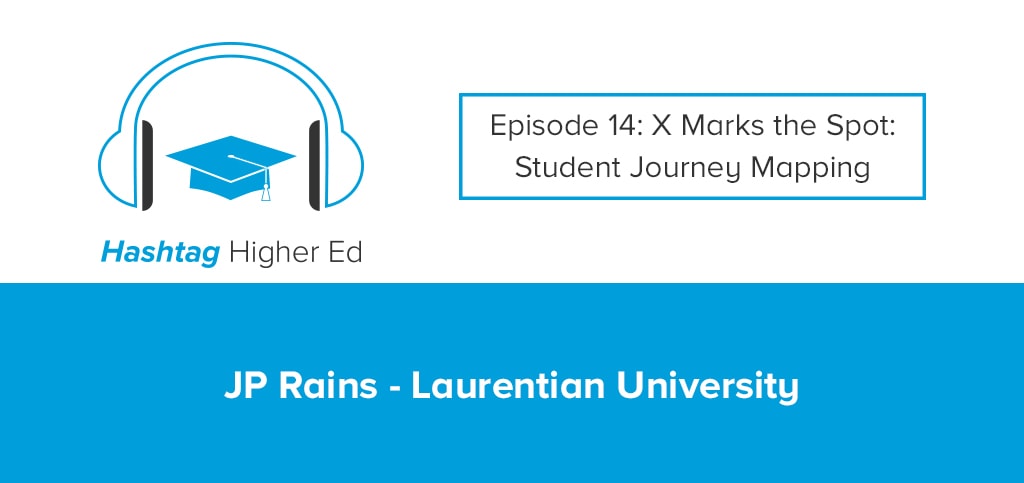Much has been written about the complicated nature of choosing, applying to, and enrolling in a college. The process is often a messy, confusing, and stressful experience for both prospective students and their parents during what should be one of the most exciting times in their lives. But it doesn’t need to be this way.
Student journey mapping offers a way for institutions to collect data from real students, parents, alumni, and donors regarding the barriers they face along their journeys and how to eliminate these pain points through a simplified process. Using these maps, higher ed administrators are able to zoom out, gain a better understanding of the challenges their audiences face, and implement solutions that address these pressing problems.
To discuss student journey mapping in more detail, we welcomed JP Rains, Laurentian University’s Director of Digital Strategy, to the Hashtag Higher Ed Podcast. In this episode, Rains explains why your institution needs a student journey map and offers a step-by-step guide to creating journey maps that lead to tangible improvements in the customer experience.
What is student journey mapping, and why does it matter?
“One of the challenges or opportunities for us in higher education is that students are both our consumer and our product,” says Rains, who sees student journey mapping as a core building block of a student-centric experience. “We really have to focus on them before anything else.”
“When you’re building the student journey, you’re building the case for making data-driven decisions that are based off of student experiences,” says Rains. In Rains’ experience, student journey mapping allows higher ed institutions to answer three key questions:
- What are the most important elements of the student journey and what challenges does your institution face within those particular elements?
- Where should you focus institutional efforts to have the biggest impact on the student journey?
- What impact has your efforts had on qualitative metrics like student satisfaction within specific steps of the journey?
When should schools implement student journey mapping?
“There’s no bad time to start,” says Rains. “I often see institutions embarking on mapping the student journey while that’s aligned with other process changes.” This allows schools to benchmark where they are now and measure the impact of process changes they think will improve the student journey.
Having a student journey map effectively “eliminates a lot of the anecdotal conversations that can sometimes be counterintuitive to some of the data you gathered,” says Rains. Common opportunities to take advantage of such data-driven decision making include strategic plan initiatives, major web project rebuilds, or process changes.
What are the key elements of the student journey map?
According to Rains, there are seven essential elements involved in student journey mapping.
1. Entry points: Where does the journey begin? What was the first point of contact a prospective student had in terms of an interaction with your brand? There are usually three major types of entry points: in-person, online, and social media.
2. Audience: Who are you focusing on? “I recommend [student journey maps] to be focused on audiences,” says Rains. “Those goals, activities, emotions, and barriers are going to be different depending on your audience type.” For example, focusing on prospective students could involve creating three different maps for domestic students, international students, and online students.
3. Goals: What are the goals your target audience is looking to achieve? “I like to have no more than three goals as part of an audience member’s journey,” says Rains. A prospective student’s three main goals in the application process might be to narrow down their short list of schools and apply to them, receive an offer of admission, and finally, to enroll.
4. Activities: What are the key steps in the process that these students go through? “Goals can often be confounded with activities,” says Rains. “While a goal might be to pass all exams, an activity would be to go through the exam period.”
5. Emotions: What are students feeling during those different steps in the process? “When you identify a part of the student journey that says at this point, the student is very stressed out, you need to be cognizant of that and reduce the level of things you’re expecting from them,” says Rains.
6. Barriers: What are the biggest challenges students face at each stage in the journey? “The student journey can be very complex. How do you internalize that complexity as an organization and provide simplicity to your student experience?” says Rains of how to effectively address barriers.
7. Insights: What can we do to simplify each step in the student journey? “These insights will really form your implementation plan,” says Rains. After your mapping process is complete, rank your list of insights in order of priority and tackle them accordingly.
Ready to kick off student journey mapping at your institution? Listen to the full episode to hear Rains discuss the six steps involved in the student journey mapping process, how to avoid common challenges that may crop up, and tips for getting started today.
Many thanks to JP Rains for joining us on this episode of the Hashtag Higher Ed Podcast. You can find JP on LinkedIn, Twitter (@jp_Rains), or by visiting his website.
Listen to this episode, and previous episodes of the Hashtag Higher Ed Podcast, on Soundcloud, iTunes, Google Music, or wherever podcasts are found. To explore previous episodes of the Hashtag Higher Ed podcast and sign up for alerts regarding new episodes, visit our Hashtag Higher Ed hub.




